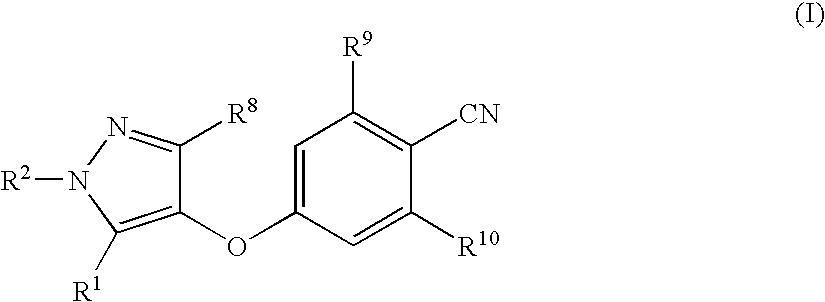Compounds useful in therapy
a technology of compounds and compounds, applied in the field of compounds, can solve the problems of rapid loss depletion of bone mineral density, and without unwanted side effects
- Summary
- Abstract
- Description
- Claims
- Application Information
AI Technical Summary
Problems solved by technology
Method used
Image
Examples
example 1
4-[(3,5-Dimethyl-1H-pyrazol-4-yl)oxy]benzonitrile
[0404]
[0405] The benzonitrile of Preparation 1 (7.2 g, 33 mmol) was dissolved in acetic acid (70 ml). Hydrazine hydrate (1.9 ml, 39.7 mmol) was then added, and the reaction mixture was stirred at room temperature for 1 hour, under nitrogen. It was then concentrated under reduced pressure, and the residue was purified by flash chromatography on silica gel eluting with dichloromethane:ethyl acetate (3:1 then 1:1, by volume) to provide the title compound (4.09 g, 88%) as a pale yellow solid.
[0406]1H-NMR (400 MHz, CDCl3): δ=2.12 (s, 6H), 6.96 (d, 2H), 7.59 (d, 2H); LRMS: ESI−: m / z 212 [M-H]−. Microanalysis: Found: C, 67.48; H, 5.24; N, 19.49%. C12H11N3O requires C, 67.59; H, 5.20; N, 19.71%.
examples 2 & 3
4-(5-Cyclopropyl-3-methyl-1H-pyrazol-4-yloxy)-2,6-dimethyl-benzonitrile & 4-(5-cyclopropyl-3-methyl-1H-pyrazol-4-yloxy)-2-methyl-benzonitrile
[0407]
[0408] The compounds of the general formula shown above were prepared by a similar method to that described for Example 1 using the appropriate benzonitrile of Preparations 12 and 14 as the starting material.
Ex NoR10Analytical Data2Me1H-NMR(400MHz, CDCl3): δ=0.76-0.82(m, 4H),1.67(m, 1H), 2.08(s, 3H), 2.47(s, 6H), 6.64(s, 2H);LRMS: APCl+: m / z 268[MH+]; APCl−: m / z 266[M−H]−;62% yield3H1H-NMR(400MHz, CDCl3): δ=0.77-0.81(m, 4H),1.66(m, 1H), 2.08(s, 3H), 2.50(s, 3H), 6.77(d, 1H),6.84(s, 1H), 7.52(d, 1H); LRMS: APCl+: m / z 254[MH+];APCl−: m / z 252[M−H]−; 71% yield
example 4
4-[(3,5-Dicyclopropyl-1H-pyrazol-4-yl)oxy]-2,6-dimethylbenzonitrile
[0409]
[0410] The chlorodiketone of Preparation 6 (13 g, 69.9 mmol) was added to a solution of 2,6-dimethyl-4-hydroxybenzonitrile (13.36 g, 90.9 mmol) and caesium carbonate (29.6 g, 90.8 mmol) in acetone (200 ml). The reaction mixture was then heated at 60° C. for 8 hours. After cooling, it was concentrated under reduced pressure. 2N Hydrochloric acid was added (100 ml) and the mixture was then extracted with dichloromethane (150 ml). The organic layers were separated, washed with brine, dried over magnesium sulphate, filtered and concentrated under reduced pressure to give crude diketone intermediate (22 g, ˜90% pure, ˜65 mmol). A portion of this (19 g) was added to a solution of hydrazine hydrate (4 ml, 82.3 mmol) in acetic acid (200 ml) and ethanol (50 ml). The reaction mixture was stirred at room temperature for 18 hours under nitrogen, and then concentrated under reduced pressure. Water (100 ml) was added, and t...
PUM
| Property | Measurement | Unit |
|---|---|---|
| weight % | aaaaa | aaaaa |
| weight % | aaaaa | aaaaa |
| weight % | aaaaa | aaaaa |
Abstract
Description
Claims
Application Information
 Login to View More
Login to View More - R&D
- Intellectual Property
- Life Sciences
- Materials
- Tech Scout
- Unparalleled Data Quality
- Higher Quality Content
- 60% Fewer Hallucinations
Browse by: Latest US Patents, China's latest patents, Technical Efficacy Thesaurus, Application Domain, Technology Topic, Popular Technical Reports.
© 2025 PatSnap. All rights reserved.Legal|Privacy policy|Modern Slavery Act Transparency Statement|Sitemap|About US| Contact US: help@patsnap.com



